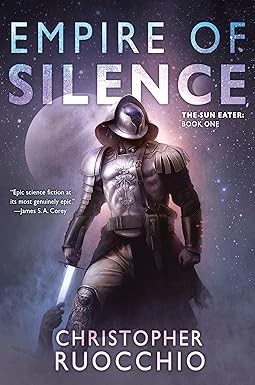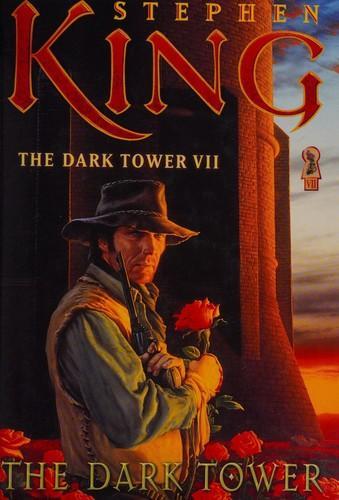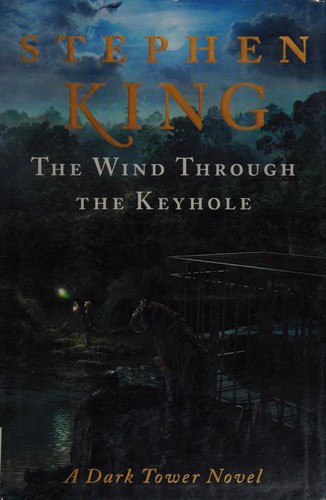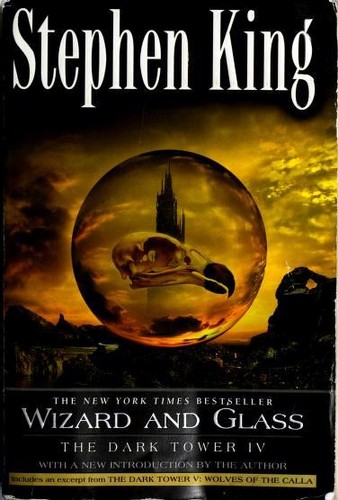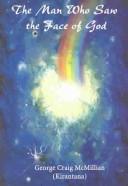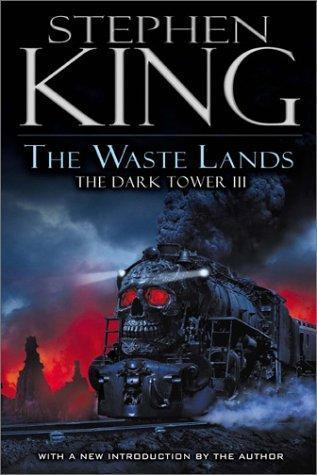O discordia
Reviews and Comments
Landscape designer in the NC Mountains and Piedmont | Proprietor of KALEIOPE Environmental Design | Autodidact Polymath | Certified Meteobierologue | Avid reader | Reluctant SysAdmin
This link opens in a pop-up window
Peter W. Flint started reading The Dark Tower VII: The Dark Tower by Stephen King
Peter W. Flint finished reading The Wind Through the Keyhole (The Dark Tower, #4.5) by Stephen King (The Dark Tower, #4.5)
Content warning Personal commentary that might contain spoilers
This was a quick and refreshing break from the saga to come that will have all but one beloved character dead at the end. And yet I still found myself crying in the shower this morning as I unpacked its thematic content.
There are three layers to this story. The first is an interlude between the formative events of the Dark Tower ka-tet and their journey into End World that comprises the last three novels. The second is a portrait of Roland’s development into a full-fledged gunslinger. The third is a fairy tale that ties the Roland of youth and Roland as adult together. The first layer takes up only 10% of the narrative, but becomes fundamental to the reader’s understanding of Roland as dinh of his ka-tet, and why his companions will sacrifice themselves for the quest at large when the time comes.
The second layer sees Roland, still a teenager, grieving his role in his mother’s death and sent to the outskirts of Gilead to deal with a Skin Man, a murdering shapeshifter. Here he meets a priestess who knew his mother in the context of healing from her indiscretions and recovering her mental health, someone who knew her as a woman and not in her societal role. While this encounter feels tangential to the arc of the Skin Man narrative, it is pivotal to Roland’s character development as a whole.
The third layer is introduced as Roland comforts a young boy who has lost his father to the skin man, now an orphan. He tells the story of the Wind Through the Keyhole, how the boy Tim was lured into the Endless Forest to save his mother’s sight. The themes of this story revolve around spousal abuse, but for Roland I think it is really being told as a way to reclaim his childhood innocence, returning to a time when his own mother would tell him bedtime stories, before life got complicated and tragic. Tim survives the challenges of the wilderness, retrieves his magical elixir and his mothers sight, enabling her to kill his stepfather with her dead husband’s axe. Figuratively, for Roland, Mother and Son are reunited against the patriarchal model of the society they must exist within.
Roland finishes his fairy tale and returns to the plot of the skin man. He is flushed out of hiding and dealt with in the gunslingers way. There is probably a theme to explore here in the context of shapeshifting and violence, but these are not resonating with me this go round. In the aftermath of the tale, Roland approaches the priestess to see about taking in the orphaned boy. She agrees but also hands Roland a letter from his mother. In this letter, she confesses to ending her recovery prematurely, to returning to Gilead under dark influences, and to knowing the outcome of this decision: death at the hand of her only son. It is a foretelling that Roland receives only after the deeds are done. He takes the news in with the appropriate grief and tears, alluding to the last lines of her letter that he spent years and years tracing over before he came to terms with them.
The story returns to its first layer, adult Roland and ka-tet passing the time with a tale while waiting out a storm. Here we learn those last lines of the letter, asked privately by Susannah, herself in the early stages of pregnancy (though as yet unaware of it). We discover that despite knowing her demise, Gabrielle Deschain stepped onto the wheel of ka and allowed events to take their course. In the distortion and confusion of much larger circumstances, her son ended her life and proceeded along his own path of inner suffering. Within all this knowledge, she asks,
“I forgive you everything, do you forgive me?”
Only through and after the countless years of turmoil, resignation, and the telling of the tale, Roland finds he does, and this brings him great joy.
This Atonement with the Mother, is a theme I’ve not seen anywhere else, at least not in the fantasy and fiction I’ve read over the years. In most story-telling, the Mother is the source of safety and shelter, or inverted into the object to be restored. She is not the source of suffering but its salve. The Father tends to be the cause of conflict and object of atonement, as Joseph Campbell argues in The Hero with a Thousand Faces. It’s another example of King’s ability to iterate over familiar themes through his willingness to take on the darkness of the human heart. Mothers can also cause harm, however unintentional or driven by subconscious processes. This was my childhood experience. This story, as stories are meant to do, revealed to me that my mom and I have walked the path of forgiveness and formed an enviable adult relationship.
Peter W. Flint started reading The Wind Through the Keyhole (The Dark Tower, #4.5) by Stephen King (The Dark Tower, #4.5)
Peter W. Flint commented on Wizard and Glass by Stephen King (The Dark Tower IV)
Time has turned forward again. Roland has finished his tale and confrontation with his past.
I find myself more interested in the evolution of Susan and Roland’s relationship this go round than the historical, world-building context development of the Dark Tower universe. How they evolve from mutual attraction and descend into idealism and addiction, covering their inability to control their lust with romantic fantasies, ultimately finding themselves unable to read the antagonistic reality organizing itself around them. In the end, I found myself grateful for having weathered similar situations, coming to my own adult understanding of balancing powerful feelings with bounded reason.
Susan’s experience as the story comes to a close illustrates a feminine trinity that complements that of Roland’s ka-tet, a corruption of the tripartite woman as maiden/mother/crone. As Susan loses her maidenhood and becomes a mother herself, her aunt Cordelia, her mother-figure yet spinster, descends into jealousy, …
Time has turned forward again. Roland has finished his tale and confrontation with his past.
I find myself more interested in the evolution of Susan and Roland’s relationship this go round than the historical, world-building context development of the Dark Tower universe. How they evolve from mutual attraction and descend into idealism and addiction, covering their inability to control their lust with romantic fantasies, ultimately finding themselves unable to read the antagonistic reality organizing itself around them. In the end, I found myself grateful for having weathered similar situations, coming to my own adult understanding of balancing powerful feelings with bounded reason.
Susan’s experience as the story comes to a close illustrates a feminine trinity that complements that of Roland’s ka-tet, a corruption of the tripartite woman as maiden/mother/crone. As Susan loses her maidenhood and becomes a mother herself, her aunt Cordelia, her mother-figure yet spinster, descends into jealousy, contorting the role while egged on by the equally corrupted crone archetype of Rhea the witch. There’s a theme here on the classically understood social lives of women that I’m not really qualified to comment on, but seems to center around sources of envy within women’s circles and the behavior it engenders. In Susan’s case, it exemplifies how the stewards of life become destroyers of it.
Lastly, King makes an allusion that I never picked up on in earlier reads, and not sure if he develops it later in the series. The Dark Tower is the nexus of existence. We might think of it as a physical manifestation of metaphysics itself. The center of Being. It’s a powerful image that can be applied through a number of Eastern models of metaphysics. As Roland comes to understand his quest to enter and repair the sickness within the Dark Tower, he recognizes an opposing force, the Bright Tower of love, perhaps the energy that issues from and animates existence itself. The thing that Moves and Organizes beyond individual will. Between these two sits ka, a complex term encountered throughout the series. As with most of his symbolism, King leaves this idea open-ended, allowing the reader to make his own interpretations.
Peter W. Flint commented on Wizard and Glass by Stephen King (The Dark Tower IV)
Susan and Roland are now deep into their affair as the tension of the adjacent political arc builds. Roland’s companions express dismay at their friend’s loss of objectivity in fulfilling the obligations of their purpose in Mejis.
Where initially I related to Roland and Susan’s dynamic as their attraction budded into a relationship, I’m now seeing where they depart from my own story. Both characters seem drawn to each other due to their loss of innocence; believing the world to be a certain way and coming to learn it is more complex. Each beginning to come into their own agency as a result, but lacking any real experience. Roland’s injury is learning of his mother’s indiscretions, her weakness (as he sees it), and inability withstand temptation despite her devotion to her son and family. Susan’s injury is the loss of her father and ensuing circumstances that lead her to agree …
Susan and Roland are now deep into their affair as the tension of the adjacent political arc builds. Roland’s companions express dismay at their friend’s loss of objectivity in fulfilling the obligations of their purpose in Mejis.
Where initially I related to Roland and Susan’s dynamic as their attraction budded into a relationship, I’m now seeing where they depart from my own story. Both characters seem drawn to each other due to their loss of innocence; believing the world to be a certain way and coming to learn it is more complex. Each beginning to come into their own agency as a result, but lacking any real experience. Roland’s injury is learning of his mother’s indiscretions, her weakness (as he sees it), and inability withstand temptation despite her devotion to her son and family. Susan’s injury is the loss of her father and ensuing circumstances that lead her to agree to become a concubine, then to learn that her fathers death and those circumstances were engineered by darker forces of politics and greed. In a way, their union is reclaiming that loss of innocence. Forming a youthful alliance against the machinations of the world of adults. But for both, the core wound occurs as a threshold into adolescence. Each received love and attention from their parents then lost it.
For some, including myself, the core wound is deeper and goes much further back. The loss of innocence occurs before memory can form, the experience named, and the remedy identified. It becomes a formative psychic event that is only available to us as hearsay. Our process of reclamation and healing is not as simple.
Peter W. Flint commented on Wizard and Glass by Stephen King (The Dark Tower IV)
Roland and Susan remain in their early courtship, both attending to their own duties while being drawn toward one another, yet resisting the attraction.
I’m noticing more empathy for Susan this go round. She is immersed in her own life and community when suddenly a stranger appears with a new perspective, and after she’s made hard but practical decisions to support her family and future. Forced into her decision by circumstance and accepting it when an alternative appears. Roland brings forth her inner will, and she sets it against him to preserve the status quo, while longing for him all the same.
Meanwhile, Roland and his ka-tet are illustrating a developing theme I might call the tripartite man, to borrow from feminine images of the Hera/Aphrodite/Artemis triplicate. Cuthbert as the Fool/Trickster, Alain as the Squire, Roland as the Knight. Incomplete in their adulthood and forming a whole man together. …
Roland and Susan remain in their early courtship, both attending to their own duties while being drawn toward one another, yet resisting the attraction.
I’m noticing more empathy for Susan this go round. She is immersed in her own life and community when suddenly a stranger appears with a new perspective, and after she’s made hard but practical decisions to support her family and future. Forced into her decision by circumstance and accepting it when an alternative appears. Roland brings forth her inner will, and she sets it against him to preserve the status quo, while longing for him all the same.
Meanwhile, Roland and his ka-tet are illustrating a developing theme I might call the tripartite man, to borrow from feminine images of the Hera/Aphrodite/Artemis triplicate. Cuthbert as the Fool/Trickster, Alain as the Squire, Roland as the Knight. Incomplete in their adulthood and forming a whole man together. Eventually Susan will join the ka-tet to form a quaternity, reflecting the group of characters that form the saga’s arc, but the idea of masculine trinity is compelling. These are youthful roles that will ultimately be integrated into the man Roland will become.
Peter W. Flint commented on Wizard and Glass by Stephen King (The Dark Tower IV)
Time has turned backwards and Roland and his first ka-tet have arrived in Mejis. Roland and Susan Delgado have encountered each other on the road and entered into a secret friendship.
I relate very much to young Roland in his experience of becoming enraptured by a beautiful woman on account of both her pleasing appearance and her warmth of personality. I also see his folly, as he begins to set aside all his obligations to pursue his heart’s desire. And I know this situation doesn’t end well for Susan. Their passion burns through all social convention and restraint.
I had a similar experience recently as an adult. Overwhelmed by the beauty I saw in another and setting aside my obligations to myself in order to be available to her. I exercised some measure of restraint and we both remain intact although our relationship is not.
I continue to appreciate King’s …
Time has turned backwards and Roland and his first ka-tet have arrived in Mejis. Roland and Susan Delgado have encountered each other on the road and entered into a secret friendship.
I relate very much to young Roland in his experience of becoming enraptured by a beautiful woman on account of both her pleasing appearance and her warmth of personality. I also see his folly, as he begins to set aside all his obligations to pursue his heart’s desire. And I know this situation doesn’t end well for Susan. Their passion burns through all social convention and restraint.
I had a similar experience recently as an adult. Overwhelmed by the beauty I saw in another and setting aside my obligations to myself in order to be available to her. I exercised some measure of restraint and we both remain intact although our relationship is not.
I continue to appreciate King’s grasp of the complexity of the human heart, how love destroys as much as it heals, how situations create darkness in people, and how good stories and rewarding relationships are never free of conflict or crisis.
Peter W. Flint commented on Wizard and Glass by Stephen King (The Dark Tower IV)
Roland and ka-tet have wound their way through the thinny and Kansas Turnpike. Roland is imminently about to tell the tale of Susan Delgado and I am pausing again because I think the story is going to break me.
Peter W. Flint started reading Wizard and Glass by Stephen King (The Dark Tower IV)
Peter W. Flint stopped reading Man Who Saw the Face of God by George McMillian
Peter W. Flint commented on Man Who Saw the Face of God by George McMillian
Ugh…still reading despite my inner protests. The proofreading, if any, is terrible. But there are enough interesting ways of seeing other topics I’m exploring independently to keep me engaged.
Most salient, he notices this idea of “thought clouds” (my term) as a phenomenon of organizational psychology. It’s basically the image of how a belief system/plausibility structure of an institution or social group seems to influence an individual’s ability to think independently. When we move through a group we pick up on these thought clouds through environmental affordances and behavioral cues and adjust our thinking and role to fit in. You do it. I do it. It’s just something we do.
The image is consistent with the theory of the conscious electromagnetic information field; consciousness arises through the combined wave interference of independently firing neural synapses. It’s proven that music will synchronize individual brainwaves in an audience, so the idea that …
Ugh…still reading despite my inner protests. The proofreading, if any, is terrible. But there are enough interesting ways of seeing other topics I’m exploring independently to keep me engaged.
Most salient, he notices this idea of “thought clouds” (my term) as a phenomenon of organizational psychology. It’s basically the image of how a belief system/plausibility structure of an institution or social group seems to influence an individual’s ability to think independently. When we move through a group we pick up on these thought clouds through environmental affordances and behavioral cues and adjust our thinking and role to fit in. You do it. I do it. It’s just something we do.
The image is consistent with the theory of the conscious electromagnetic information field; consciousness arises through the combined wave interference of independently firing neural synapses. It’s proven that music will synchronize individual brainwaves in an audience, so the idea that thoughts might synchronize in a similar way isn’t out of left field. Exhibit A: human civilizations.
I think the challenge for individuals is discovering how to develop a personal belief system/plausibility structure (through solitude?) and then find others with resonant fields.
This is of course just me mumbo-jumbling on a book server that very few people read.
Peter W. Flint started reading Man Who Saw the Face of God by George McMillian
Peter W. Flint commented on The Waste Lands (The Dark Tower, #3) by Stephen King
Content warning Not really a spoiler but assumes you’ve already read the books.
Close to finishing. Pausing again to capture a few thoughts. Roland is imminently about to rescue Jake from the Tick-Tock Man and Eddie and Susannah are in the cradle of Blaine the Mono.
-
Blaine is an interesting archetype in the age of LLMs and emerging AI technologies. It is an extrapolation of technology gone insane, how it becomes essentially the Demon of Lud, an intelligence that has surpassed its programming and descended into addiction. It continues the theme of duality resolved in the arcs of Susannah, Roland, and Jake. Here the presence of Little Blaine, the remnant docility of the original program.
-
I didn’t see it before, but it seems another theme is how each member of the New York ka-tet seems to be finding their purpose beyond the expectations set by their environments. Each characters drawing into Roland’s alien world represents the struggle of starting anew and seductive comfort of familiarity. Eddie is the best illustration of this as his former heroin addiction and fear pull him backwards into old thought patterns, but ultimately allow him to see those patterns where other members of the ka-tet can’t. In other words, his liability becomes an asset.
-
Roland, in contrast, is set in his purpose and guiding the others to suit it. The backstory to his motive is coming up in the next book, but I can already see how his experience in Mejis and the death of Susan Delgado informs his perception that the nexus of existence, the Dark Tower, is sick and crumbling.
Peter W. Flint commented on The Waste Lands (The Dark Tower, #3) by Stephen King
Content warning Not really a spoiler but assumes you’ve already read the books.
Just about over halfway through, Jake has been drawn through the speaking ring and Roland and ka-tet are about to enter the city of Lud, and have stopped to palaver and share perspectives from their drawings before fully embarking on their quest.
I’m pausing for a minute to unpack the idea of ka-tet, those bound together by fate. I’m finding it a useful concept in human life outside of fantasy novels. The idea of a bond that forms at random as a result of the particular idiosyncrasies of individual personalities. We might also call this “fitting in” or “belonging.” Each individual in a ka-tet like a puzzle piece that forms a different picture when brought together. The idea of individuality no longer applies which, per the character development over the arc of the three novels, isn’t the most pleasant of experiences.

